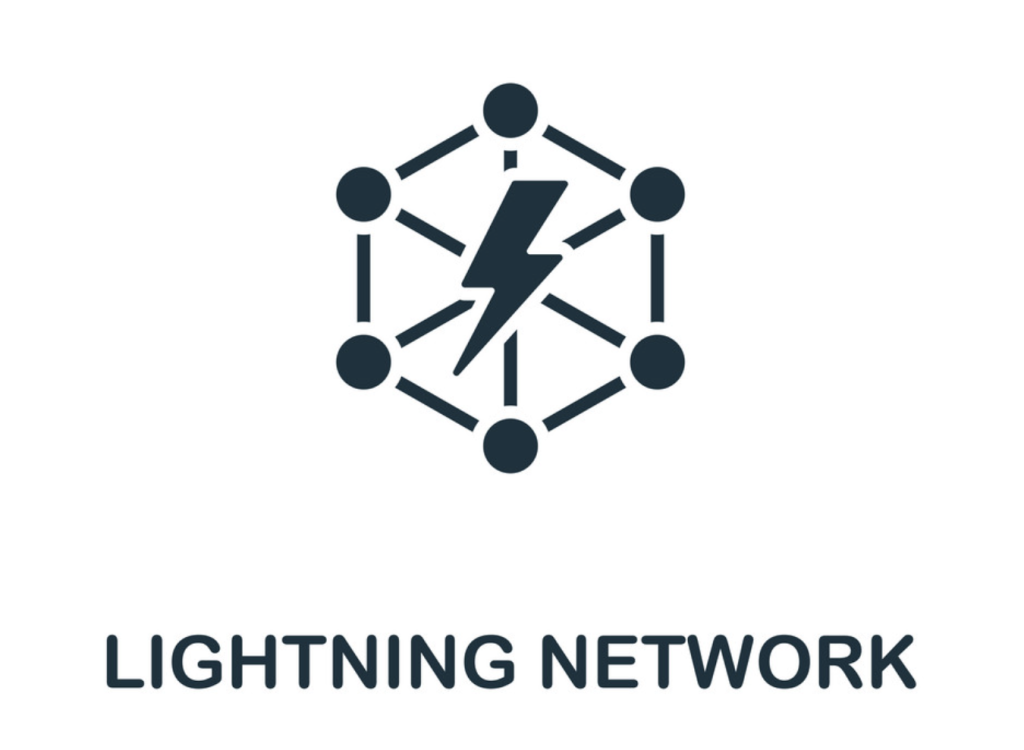The Bitcoin network has been shown to handle a relatively modest number of transactions by design. The network gets congested as more individuals use Bitcoin, lengthening transaction times and raising fees.
The Bitcoin Lightning Network addresses this very issue.
The Bitcoin Lightning Network is a secondary network built on top of the Bitcoin blockchain. It is a system of payment channels that uses micropayment channels to extend the blockchain’s capacity and handle transactions more quickly and affordably. In other words, it is a technological fix to Bitcoin’s scalability issues.
Key Takeaways
- The Bitcoin Lightning Network makes bitcoin transfers nearly instant with minimal fees, ideal for micropayments and everyday use.
- It was designed to help Bitcoin scale by handling thousands to millions of transactions per second without overloading the network.
- Transactions occur off-chain through user-created channels, reducing congestion on the main Bitcoin blockchain.
Understanding Bitcoin’s Scalability Challenge
Bitcoin was originally designed to be a decentralized payment system that users could access from anywhere while maintaining their anonymity. The network was envisioned and developed as a peer-to-peer electronic cash system. Users did not need an intermediary to transfer value.
The challenge, however, was that Bitcoin’s creators focused on only these features, ignoring scalability and transaction throughput.
This issue became increasingly problematic as the years passed. The Blockchain Trilemma, as it was generally known, required blockchain architects to strike the correct balance between decentralization, scalability, and security. The Bitcoin network has proven its mettle for decentralized and secure transactions. But scalability continues to be an issue.

Transactions on the Bitcoin network can take between a few minutes to several hours. The challenge has become even more serious as new blockchains like Ethereum and Solana have emerged with higher transaction throughput. Ethereum’s 30 transactions per second (TPS) far exceeds the 5 TPS of Bitcoin. Solana, on the other hand, elevates the comparison to new heights with up to 65,000 TPS.
With the emergence of scalable blockchains, Bitcoin has no choice but to rely on layer 2 solutions if it wishes to have a strong application ecosystem with a desirable user experience. The Lightning Network is by far the most significant layer-2 chain of Bitcoin, providing several key features and advantages.
What is the Lightning Network?
The Lightning Network is a layer-2 solution built on top of Bitcoin. It uses multi-signature wallets to let users conduct transactions off-chain without waiting for block confirmations.
First suggested in a whitepaper in 2016 by Thaddeus Dryja and Joseph Poon, part of the reason for creating the Lightning Network was to make Bitcoin operate more like the virtual currency that Bitcoin’s creator, Satoshi Nakamoto, had in mind. With costs that are often fractions of a cent, it executes transactions off-chain significantly more swiftly and cheaply than Bitcoin’s primary blockchain.
Additionally, Lightning Network transactions use less energy than those on the main network. It has a theoretical capacity of millions of transactions per second, as compared to the main network’s capacity of less than 10 TPS.
How Does the Lightning Network Work?
The Lightning Network allows the Bitcoin protocol to stay mostly intact while offering the advantages that significant reworkings might bring.
On the Lightning Network, two parties must establish a payment channel, of which only the first and last transactions are recorded on the Bitcoin blockchain. Any number of transactions between the first and last will take place off-chain, meaning that the Bitcoin protocol does not limit those transactions.
Both parties must commit a certain amount of Bitcoin to open a payment channel. As long as the payment channel is active, Bitcoin is being held and cannot be released. The entire amount of Bitcoin committed is equal to the total amount of Bitcoin that can be transmitted through this channel.
Users may terminate their payment channels and settle their outstanding balances on the main blockchain whenever they want.
Since only the opening and closing of payment channels are recorded on the main blockchain, the entire blockchain network moves much more swiftly. Additionally, because layer 1 transactions all appear on a public and visible record, Lightning Network transactions may be more private than those done on the main blockchain.
Operational Features of the Bitcoin Lightning Network
Off-Chain Transactions
The Lightning Network functions as a second layer on top of Bitcoin that enables off-chain transactions. This means that instead of recording every individual payment on the Bitcoin blockchain, users conduct transactions privately within a payment channel.
Only two transactions are ultimately recorded on-chain: the opening and closing of the channel. By moving the bulk of activity off-chain, the Lightning Network significantly reduces congestion on the main Bitcoin network and enables faster, more scalable payment flows.
Bi-Directional Payment Channel
Lightning payment channels are bi-directional, meaning that once a channel is opened between two parties, they can send and receive bitcoin back and forth without needing to interact with the blockchain each time. This is accomplished through cryptographic updates to a shared balance.
The funds within the channel are securely managed through signed commitment transactions that reflect the current distribution of bitcoin between the two users. These updates are trustless and enforceable, enabling smooth two-way payments until the channel is closed.
Instant Settlement
One of the most appealing features of the Lightning Network is its ability to settle payments almost instantly. Unlike on-chain Bitcoin transactions, which take around 10 minutes per confirmation (and longer for additional confirmations), Lightning payments are completed in milliseconds once a valid route is found.
Low Transaction Fees
Lightning Network payments incur extremely low fees compared to traditional Bitcoin transactions. Instead of paying miners, users pay a tiny routing fee to the nodes that forward the payment through the network. These fees are usually a fraction of a satoshi, making Lightning ideal for micropayments and frequent small-value transactions.
Multi-Hop Routing
The Lightning Network doesn’t require users to have a direct channel with everyone they want to pay. Instead, payments can be routed through multiple intermediary nodes using a mechanism called Hashed Timelock Contracts (HTLCs). This allows a user to send a payment to someone else by passing it along a path of connected channels. Each node along the path only forwards the payment if the next hop succeeds, ensuring secure and atomic delivery across the network, even if the sender and recipient have never connected directly.
Lightning Network Features and Advantages
Despite still being in its infancy, Lightning Network has the potential to play a significant role in the Bitcoin ecosystem. The enhancement of speed, effectiveness, and scalability of the Bitcoin network are some of the clear advantages of the Lightning Network, as elaborated through its features below.
Off-Chain Payments
The Lightning Network creates payment channels between users to handle multiple transactions without depending on the slower main net to confirm individual exchanges.
Parties may transfer funds among themselves as needed with bidirectional payments. After the channel has been closed, the transactions are sent to the main net for confirmation.
Such rapid off-chain transactions significantly increase the network’s speed and efficiency. The time needed for blockchain confirmations does not apply to these transactions because they are not broadcast to the Bitcoin blockchain right away. Instead, the parties can conduct their business rapidly and secretly within the channel, enabling almost immediate resolution.
Ethereum and Litecoin are other crypto assets that support off-chain payment options.
Atomic Swaps
Different cryptocurrencies that are compliant with the Lightning Network protocol can be exchanged using atomic swaps on the Lightning Network without the need for a centralized exchange. For instance, Bitcoin may be swapped for Litecoin on the Lightning Network without having to rely on a third party.
Atomic swaps, often referred to as cross-chain swaps, are exchanges of cryptocurrencies between two parties on various blockchains that don’t involve a middleman or other reliable third party. They make it possible for exchanges to be trustless and decentralized since they do away with the requirement for centralized exchanges or middlemen to help with transactions.
Security and Privacy
There is more security and control over the assets being traded because the swaps take place directly between the involved parties using smart contracts and cryptographic techniques. By removing the need to rely on a third party, atomic swaps lower the danger of hacking, fraud, or money loss associated with centralized exchanges.
Atomic swaps also make it possible for direct peer-to-peer transactions, protecting participant privacy and minimizing the need to divulge private information to an exchange. By permitting direct exchanges between various cryptocurrencies, atomic swaps improve liquidity and give consumers access to a greater variety of trading choices.
Micropayments
Micropayments involve exchanges of extremely small sums, frequently cent-sized amounts. Such low-value transactions are often economically unviable due to the hefty transaction fees imposed by traditional payment methods and blockchain networks.
With the Lightning Network being off-chain, it enables micropayments to be made with very little, if any, transaction costs, which makes them useful and affordable.
Scalability
By lightening the load on the underlying blockchain, micropayments address the scalability issues of blockchain networks. Micropayments do not need to be recorded on the blockchain for every transaction because they are made off-chain through payment channels.
This allows for a higher volume of transactions and considerably reduces congestion, which improves scalability and throughput.
Innovative Business Models
Innovative business models that were previously unfeasible or impossible due to hefty transaction fees can now be realized thanks to micropayments. Small fees can be charged for specific pieces of material, access to premium features, or pay-per-use services, allowing content producers, artists, bloggers, and other digital content providers to monetize their work on a more granular level while opening up new revenue opportunities.
IoT and M2M Transactions
Micropayments allow for quick, inexpensive transactions between linked, automated devices as more of them engage in these interactions. This creates possibilities for a range of applications, including payments for driverless vehicles, services for smart homes, energy microtransactions, and more.
Gaming and Virtual Economies
The gaming and virtual economies rely heavily on micropayments. The Lightning Network can be used to support in-game purchases, microtransactions for virtual products, and micro-rewards for accomplishments, improving user experience and enabling frictionless and immediate value exchange within gaming ecosystems.
Financial Inclusion
Micropayments over the Lightning Network can promote financial inclusion by giving people in underserved or unbanked areas access to financial services. Because of its low transaction fees and capacity for microtransactions, the Lightning Network can offer economical and accessible payment solutions to populations that previously had access to traditional financial infrastructure.
Lightning Network Challenges
The Lightning Network is also prone to various challenges. One of the most obvious flaws is that it could replicate the hub-and-spoke model that defines today’s financial systems; in other words, the system where banks and other financial organizations serve as the main middlemen for all transactions.
By having more open connections with others, companies that invest in Lightning Network nodes may become comparable hubs or centralized nodes in the network.
Other issues with the Lightning Network include limited adoption, price fluctuations, complexity, and security risks such as fraud and hacking. These challenges need to be taken into account before using the Lightning Network solution.
Current State and Adoption of the Lightning Network
Since its inception, the Lightning Network has shown significant growth and development. Thousands of Bitcoins are currently available on the network, allowing for a higher volume of transactions.
The number of channels and nodes on the Lightning Network has also been rising steadily. Nodes take part in the network as participants, and channels help with transactions. The network’s overall resiliency and liquidity are boosted by such expanding number of nodes and channels.
People may now use the Lightning Network more easily for transactions since wallet providers and developers have developed user-friendly interfaces and streamlined onboarding procedures.
The security, routing effectiveness, and general functioning of the Lightning Network have also improved because of ongoing development work. As a more effective and affordable substitute for conventional payment systems, several companies and merchants have begun accepting Lightning Network payments.
It is now also easier for consumers to access and use the Lightning Network for transactions thanks to the integration of Lightning Network capabilities into several cryptocurrency wallet providers’ wallets. A vibrant developer community has also embraced the Lightning Network, supporting its continued development and growth.
Conclusion
The Bitcoin Lightning Network has advanced significantly in terms of network expansion, technological development, and company and individual usage. Several use cases for it have emerged, including tip bots and social media, cross-border transactions, micropayments, instant payments, and IoT and M2M transactions.
The Lightning Network is expected to play a bigger part in the larger Bitcoin ecosystem as development and awareness grow. Even though it is still in its infancy, there has been a rise in interest and adoption among users who want the Bitcoin network to support quicker and less expensive transactions with community-led campaigns, educational resources, and overall awareness driving its adoption.
All of this demonstrates the network’s potential to revolutionize payments and open the door to new business models.

